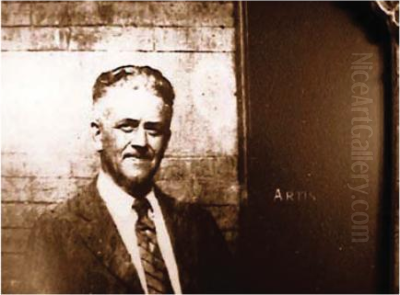
George Ames Aldrich stands as a notable figure in the landscape of American Impressionism, an artist whose career bridged the artistic ferment of late 19th and early 20th century Europe with the burgeoning art scenes of the American Midwest. Born in Worcester, Massachusetts, in 1872, Aldrich's life (1872-1941) encompassed rigorous academic training, extensive European travel and work, and a significant period of activity in Indiana and Illinois. He is best remembered for his evocative landscape paintings, particularly those capturing the unique light and atmosphere of coastal France and the distinct character of the American heartland, rendered in a vibrant Impressionist style.
Early Life and Educational Foundations
Aldrich's journey into the art world was not immediate. His early education took place at Dean Academy, a preparatory school in Franklin, Massachusetts (confused with Maine in the source), from which he graduated in 1889. Following this, his path initially led towards a more technical field. He enrolled at the prestigious Massachusetts Institute of Technology (MIT) in Cambridge to study architecture. This period, however, marked a transition; while he did not complete his architectural degree, his time at MIT included involvement with the institute's Art Students League between 1891 and 1892, suggesting a growing inclination towards the fine arts. This early exposure to structured design principles may have subtly informed his later compositional strategies in painting.
The definitive shift towards painting occurred shortly thereafter. Recognizing his true calling lay in the visual arts, Aldrich sought formal training. He spent some time studying at the Art Students League of New York, a crucible for many prominent American artists, around 1890-1891. This institution, known for fostering diverse talents like William Merritt Chase and Robert Henri (though Aldrich's direct teachers there aren't specified in the source), would have provided a foundational experience before his pivotal move abroad.
European Immersion: Training and Influences
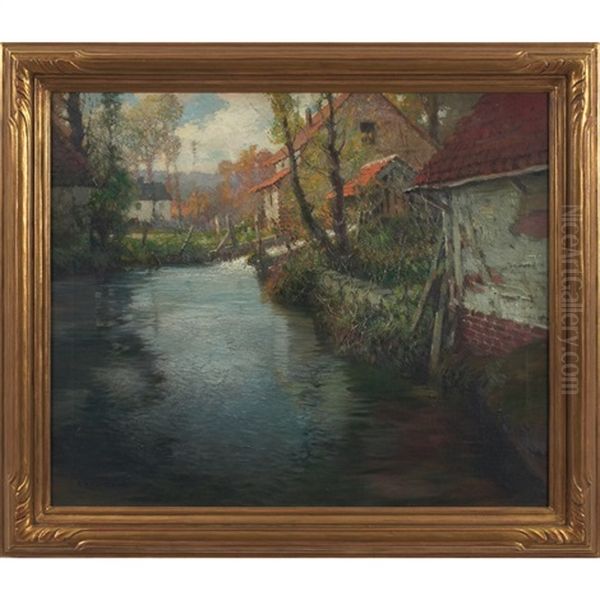
In 1893, like many aspiring American artists of his generation, Aldrich traveled to Paris, the undisputed center of the Western art world. This move was crucial for his artistic development. He immersed himself in the rigorous academic environment, studying at renowned institutions such as the Académie Julian and the Académie Colarossi. These ateliers were known for their emphasis on drawing and traditional techniques, providing a solid underpinning for his later, looser Impressionistic work. At Julian, he might have encountered instructors like Jean-Paul Laurens, known for historical painting but representative of the academic standard.
During his years in France, Aldrich actively engaged with the contemporary art scene. He became a member of the Société des Artistes Français, an important step for exhibiting and gaining recognition. His time abroad was not confined to the studios; he traveled, absorbing the landscapes and artistic currents of Europe. Sources suggest he was influenced by a range of artists. The towering figures of James McNeill Whistler, with his tonal subtleties and aestheticism, and Édouard Manet, a key precursor to Impressionism, are mentioned as influences. He also reportedly connected with contemporary figures like the society portraitist Jacques-Émile Blanche.
One source mentions study with a Norwegian painter named "Thowal" for several years, both in Paris and Nancy. While this specific name is difficult to verify and may be a misspelling or refer to a less prominent figure (perhaps Thorvald Erichsen, a contemporary Norwegian painter), the claim points to a significant mentorship during his formative European period. This extended study suggests a deep commitment to mastering his craft under European guidance. His primary subjects during this time were the picturesque regions of Normandy and Brittany, whose coastal light, quaint villages, and maritime life captivated him and became recurring motifs in his oeuvre.
Return to America: Establishing a Midwestern Presence
After his extensive European sojourn, Aldrich returned to the United States. While he maintained connections with the East Coast art world, exhibiting in New York, he established a significant presence in the American Midwest, primarily living and working in Indiana and Illinois. He became particularly associated with the art scene in South Bend, Indiana, where he settled for a considerable period. This move distinguished him from many American Impressionists who remained centered in New England or New York art colonies.
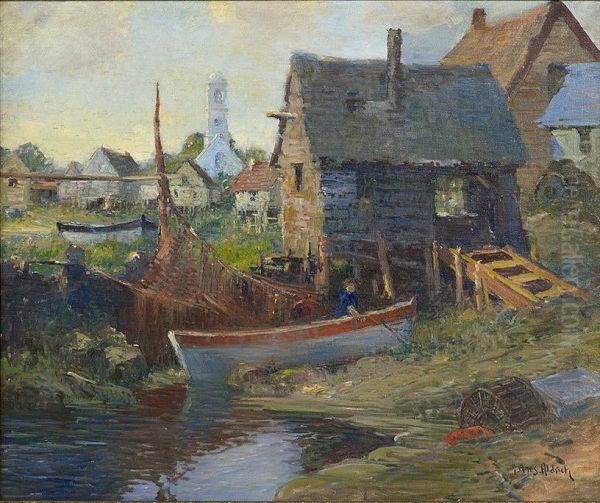
His time in the Midwest saw the consolidation of his mature artistic style. While deeply informed by French Impressionism – the focus on light, broken brushwork, and capturing fleeting moments – Aldrich developed a personal interpretation. He was particularly adept at rendering the effects of light on water and snow, capturing the crisp atmosphere of winter landscapes and the shimmering reflections in rivers and harbors. His palette was often rich and vibrant, applied with a confidence that reflected both his academic training and his Impressionist sensibilities.
His work can be situated within the broader context of American Impressionism, sharing affinities with artists like Childe Hassam or J. Alden Weir in their adaptation of French techniques to American scenes. However, Aldrich's focus often remained on European subjects even after his return, or he applied his European-honed style to the less commonly painted (by Impressionists) landscapes of the Midwest.
The Twachtman Connection and Stylistic Debates
A significant point of discussion in Aldrich's biography concerns his relationship with the prominent American Impressionist John Henry Twachtman. Some sources state that Aldrich studied with Twachtman in New York before going to Europe, while others suggest this connection occurred later or was primarily one of influence rather than direct tutelage. Twachtman, known for his highly personal and often ethereal Tonalist-Impressionist landscapes, particularly snow scenes, certainly worked in a style that resonates with some of Aldrich's own winter subjects.
This connection, however, is also linked to controversy. Some critics and art historians have noted strong similarities between Aldrich's work and that of Twachtman and other artists, leading to suggestions that Aldrich may have sometimes closely imitated or even copied elements from others. The precise nature of his relationship with Twachtman's style remains a subject of scholarly discussion – whether it was legitimate study, profound influence, or deliberate emulation. Regardless, Twachtman represents an important benchmark in American Impressionism against which Aldrich's work is sometimes measured.
Key Themes and Representative Works
Aldrich's body of work is dominated by landscapes and marine scenes. His European paintings frequently depict the harbors, villages, and waterways of Normandy and Brittany. He captured the working life of these coastal communities, the play of light on stone architecture, and the ever-changing moods of the sea and sky. His Dutch scenes, like the notable Low Tide in Holland (1919), showcase his ability to handle complex compositions involving figures, boats, and atmospheric effects under specific light conditions, such as twilight or dawn. This particular painting, depicting a horse-drawn cart near beached boats under a moody sky, exemplifies his skill in rendering reflections and capturing a sense of place.
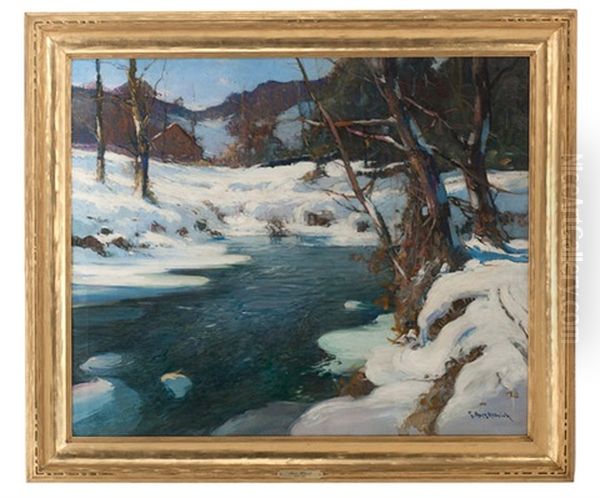
Upon returning to the US, while European themes continued, he also turned his attention to American landscapes, particularly those of the Midwest. His winter scenes are especially noteworthy. Works like Winter Trees Along the Icy Stream (c. 1920) demonstrate his mastery in depicting snow and ice, capturing the subtle colors reflected in frozen water and the stark beauty of trees against a winter sky. These works show an affinity with the Impressionist interest in seasonal effects, comparable to the winter landscapes of Claude Monet or Alfred Sisley, yet interpreted through Aldrich's distinct lens.
Beyond landscapes, Aldrich also engaged with industrial subjects, reflecting the changing American scene. His painting Steel, which won an award at the Chicago Hoosier Salon in 1929, suggests an interest in capturing the power and dynamism of modern industry, a theme less common among traditional Impressionists but explored by some American artists of the era. Additionally, Aldrich worked as an illustrator for publications such as the New York Tribune and Life magazine, demonstrating a versatility beyond easel painting.
Exhibitions, Recognition, and Artistic Circles
George Ames Aldrich achieved considerable recognition during his lifetime, particularly in the Midwest. His 1917 exhibition of four works at the prestigious Art Institute of Chicago marked an early success. A significant solo exhibition took place in 1922 at the Oliver Hotel in South Bend, Indiana, featuring fifty-four paintings. This event helped solidify his reputation in the region and showcased the breadth of his work, likely including both European and American scenes.
He was an active participant in regional exhibitions, notably the Hoosier Salon, an important venue for Indiana artists and those, like Aldrich, who resided there. His 1929 award for Steel at the Chicago iteration of the Hoosier Salon underscores his standing within this regional art community, which included prominent Indiana painters like T.C. Steele and William Forsyth, leaders of the "Hoosier Group," though Aldrich's style remained distinct from their more direct landscape approach.
His memberships included the Art Students League of New York (as a student) and the Société des Artistes Français in Paris. His works entered several collections, including the Union League Club of Chicago and the former War Mothers Museum. While perhaps not achieving the national fame of some East Coast Impressionists, Aldrich carved out a successful career and was highly regarded, especially in the Chicago and Indiana art markets.
Legacy and Conclusion
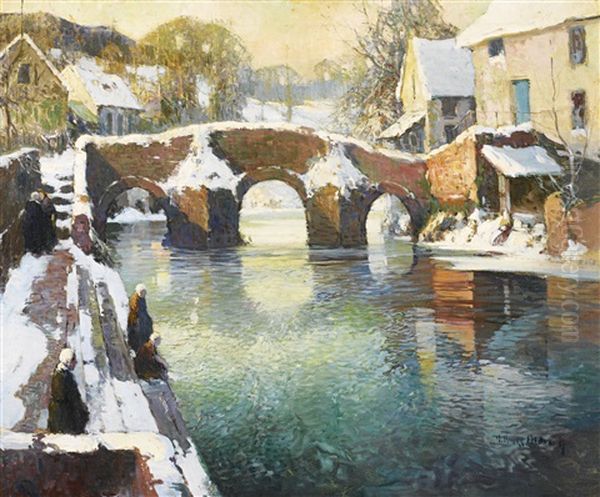
George Ames Aldrich's legacy rests on his skillful synthesis of European training and American experience. He was a prolific painter who brought the techniques and sensibilities of Impressionism, learned firsthand in France, to bear on a diverse range of subjects – from the well-trodden artistic grounds of Normandy to the less frequently depicted landscapes of the American Midwest. His particular talent for capturing atmospheric effects, especially the play of light on water and snow, remains a hallmark of his work.
While questions about influence and originality persist, particularly concerning his relationship with Twachtman's style, Aldrich's paintings possess a distinct charm and technical proficiency. His work offers a valuable perspective on the transmission and adaptation of Impressionism outside the major East Coast centers. The renewed interest in his work, evidenced by publications like Wendy Greenhouse's 2012 book The Art of George Ames Aldrich (published in conjunction with an exhibition at the Brauer Museum of Art, Valparaiso University), affirms his place as a significant regional contributor to the broader story of American Impressionism.
He remains an artist whose work reflects both the allure of European artistic traditions and a connection to the American landscape, interpreted through the vibrant lens of light and color that defines the Impressionist movement. His paintings continue to be appreciated for their evocative beauty and skillful execution, securing his position as a noteworthy American artist of his time, standing alongside contemporaries who navigated the transition from academicism to modernism, such as Frederick Carl Frieseke or Edmund C. Tarbell, each finding their own voice within the Impressionist idiom.